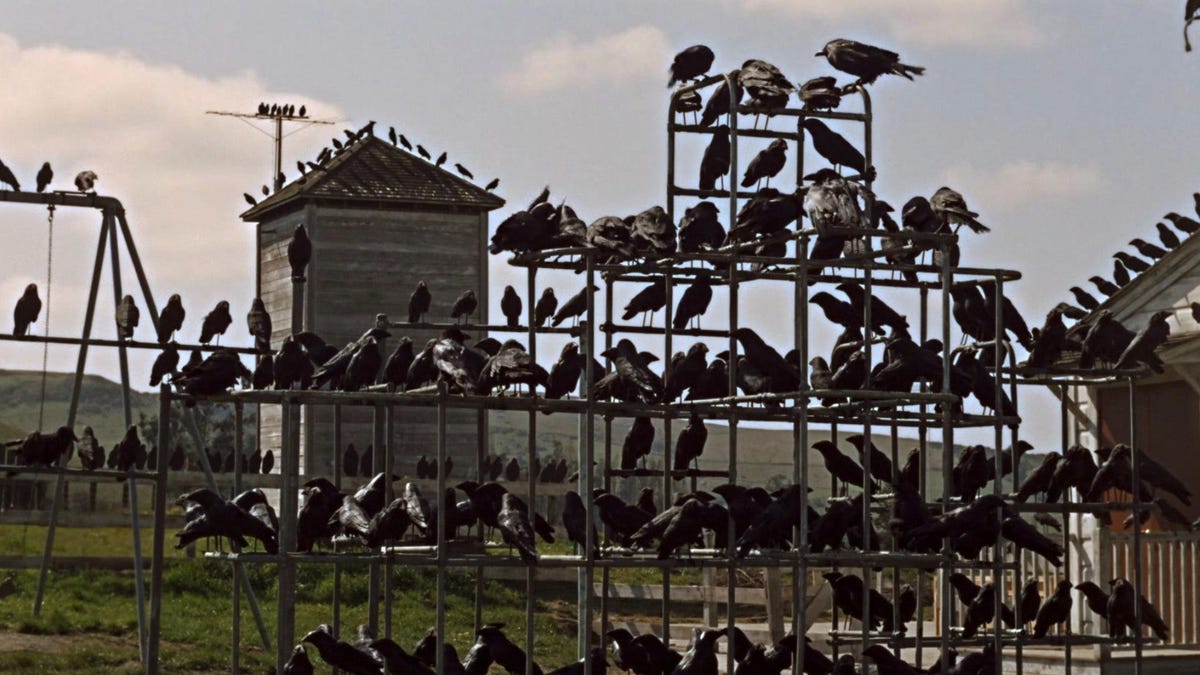15 Horror Movies Based on True Events (More or Less)
Sometimes our worst nightmares come while we’re awake. Consider the fact that while some of the most terrifying horror movies ever made vary wildly in subject matter—moving from straight-up monster movies to serial killer flicks—they have one thing in...


Sometimes our worst nightmares come while we’re awake. Consider the fact that while some of the most terrifying horror movies ever made vary wildly in subject matter—moving from straight-up monster movies to serial killer flicks—they have one thing in common: They are all (or at least claim to be) based on events that actually occurred.
How far the filmmakers have stretched “based on a true story” varies quite a lot, from movies that stay as close to the source events as possible, to films that take a ton of liberties with the truth. Here are 15 examples taken from across the spectrum.
The Blob (1958)
You wouldn’t think quintessential 1950s drive-in monster flick The Blob could be based on a true story, but it is—and it’s a well-sourced, well-documented story too.
According to a Philadelphia Inquirer article headlined “Flying ‘Saucer’ Just Dissolves,” back in 1950, a pair of policeman in Philadelphia reported seeing a mysterious object fall from the sky. They quickly drove to the landing spot and found a mass of glittery purple jelly. The cops said the thing was around six feet in diameter, filled with crystals, and pulsating. It emitted a mist of some kind too. The police called for backup and another pair of patrolmen arrived to corroborate the story. One cop stuck his hand in the goo (like you do), but he was not devoured. Within a half an hour, the strange mass evaporated.
That’s all weird enough, but it turns out gelatinous masses of space jelly falling to Earth isn’t all that unusual. There are reports of “sterre slyme” accompanying meteor-sightings dating back to the 14th Century, and people are still finding star jelly to this day. Although there are theories, no one really knows what it is, where it comes from, or what it wants.
Veracity: 6 out of 10: Unlike the monster in The Blob, real star jelly doesn’t grow to huge proportions, invade movie theaters, or devour people—at that we know about. Still, the cops’ report is pretty close to what happens at the beginning of the movie.
Streaming on: HBO Max
The Conjuring (2013)
The Conjuring is a great horror movie, and it’s based on a real family. The Perrons moved into a farmhouse in Harrisville, Rhode Island in 1971 and quickly discovered it was haunted by ghosts and a malevolent demon named Bathsheba. Or so the family said.
The case files of the paranormal investigators at the center of the film, Ed and Larraine Warren, have inspired movies like The Amittyville Horror, A Haunting in Connecticut, the Annabelle series, and many more, but whether these are true stories or not depends on what you mean by “true.”
The Warrens did start a paranormal investigation company in the 1950s. They wrote a ton of books, delivered lectures all over the world, and founded a paranormal museum that was open to the public until 2019. The Perron family did report hauntings and hold a séance too. The Conjuring house was (reportedly) once inhabited by a woman named “Bathsheba” who could have been a satanist or a witch.
But ghosts and demons are make-believe. Maybe some of the Warrens’ clients believed they were experiencing something paranormal, but the alternative theory—that the Warrens would track down the owners of houses connected to gruesome crimes, write books about ‘em, and everyone would get rich—makes sense too. I’m not knocking the Warren’s hustle. It’s genius. I’m just pointing out the possibly that maybe they weren’t being entirely honest. Shocking, I know.
Veracity: It depends on how you look at it.
Streaming on: Fubo, HBO Max
The Watcher (2022)
The Watcher is a series and not a movie, but it’s my current obsession, and is what inspired me to make this list. The Netflix series tells the story of the Broaddus family, white-collar professionals who move into an old mansion in Westfield, New Jersey only to find that it’s haunted. Not by a ghost; instead, someone (or something) is sending them creepy, disturbing letters signed “The Watcher.” The letters don’t contain threats, exactly, but they’re weirdly menacing and uniquely disturbing, and they indicate someone is completely obsessed with the house. There are numerous suspects—weird neighbors, the house’s previous owners, shady police, unethical real estate agents, the Broadduses themselves—but the perpetrators’ motives are so hard to grasp and their method so strange, it’s hard to believe anyone would bother.
Amazingly, the broad beats of The Watcher story are true. The eccentricities of neighbors are heightened for drama, characters have been added to make it more of a story, and a ton of “didn’t really happen” events have been mixed in, but the basic “weird letters come to homeowners” framework really happened. Plus: The text of letters is taken directly from the real case.
One of The Watcher’s “added” subplots concerns another white collar family man who murders his wife and kids and disappears into the night. This actually happened in Westfield too, although not to the Broadduses. Those events inspired the next entry in this list...
Veracity: 8 of 10
Streaming on: Netflix
The Stepfather (1987)
Released at the height of the 1980s slasher-movie trend, you’d be forgiven for thinking The Stepfather’s ominous title character was an invention of filmmakers hoping for a multi-movie slasher villain ala Freddie Krueger. But The Stepfather was based on a real guy, and the movie stays fairly true to the actual story.
The real stepfather was John List, an accountant and family man who lived in Westfield, New Jersey. By all accounts, List was active in his church, quiet, polite, and meticulous—until he lost his job. List never told anyone he was fired. Instead, he spent months putting on his tie in the morning, gettin on the train as if going to work, and spending all day planning to murder his family.
One seemingly ordinary day, he did it. He shot his wife, his children, and his mother, destroyed all the photos of himself from the family albums, and headed west. It was the perfect crime: no one even discovered the bodies for weeks. By then, List was long gone. He settled in Denver, got a job as an accountant under a fake name, and eventually remarried. List lived as normal guy for nearly 20 years, until a neighbor’s tip to America’s Most Wanted brought him down.
Veracity: 6 out of 10. The real List was scarier than the movie-List. Real-List wasn’t driven by rage, he didn’t make mistakes, and he stopped killing people after his first family, which makes his actions that much less explicable.
Streaming on: Fubo, Peacock, AMC+, Roku, Hoopla, Vudu, Tubi, Kanopy, Shudder, Fandor
Scream (1996)
Meta-horror classic Scream terrified teenage audiences in the mid-1990s, but they probably never knew the flick is at least partly based on the real crimes of Danny Rolling, aka “The Gainesville Ripper.” Rolling went on a four-day murder-rampage in Florida in 1990, murdering five people. His murders were, at the risk of sounding tasteless, cinematic: He posed his corpses to shock the people who would find them, said his motivation was to become a “superstar like Ted Bundy,” and set off a media frenzy much like the one that’s depicted in Scream. His murders inspired more than just the Scream franchise—Rolling has been the subject of several documentaries, books (both fiction and non), songs, podcasts, and more.
Veracity: 7 of 10. The specific details of the Scream don’t match up to Rolling’s crimes, but the overall themes are surely present.
Streaming on: Paramount+, Showtime
Compliance (2012)
Compliance is a difficult film to watch. It’s not scary in a “monsters are after us” way; instead it explores people’s willingness to compromise everything they believe in just because someone in authority tells them to, and that’s terrifying. Plus, it really happened.
The movie is based on a 2004 crime in which an unknown person dialed a McDonald’s in Kentucky and convinced the manager to strip-search and sexually assault a young worker. He got the manager to do this just by saying he was a police officer.
A prison guard in Florida was eventually arrested for the crime; he was tried for impersonating an officer and soliciting a sex act, but was acquitted. The restaurant manager and the victim’s boyfriend were found guilty for their parts in the incident, although both said they believed they were doing what police told them to. Just following orders, in other words.
The incident was one of over 70 similar crimes of record in the United States. To date, no one has been brought to justice for many of them.
Veracity: 10 of 10. This is basically what happened.
Streaming on: Hulu
8 / 17
The Texas Chainsaw Massacre (1974)
The Texas Chainsaw Massacre (1974)
Ed Gein was a quiet, mild-mannered handyman and sometimes babysitter (shudder) who spent most of his life in a remote farmhouse in Wisconsin. His existence would have passed without anyone noticing, if not for Gein’s obsession with murdering women, digging up graves to steal corpses, and his mother.
The “Plainfield Ghoul’s” gruesome crimes inspired Normal Bates in Psycho, Buffalo Bill in Silence of the Lambs, The Texas Chainsaw Massacre’s Leatherface, and, in some sense, every villain in any horror film made after 1960 or so.
Gein admitted to two murders in the late 1950s, but it wasn’t his body count that made him the father of modern horror; it was his motivations and his, uh, creativity. Like Leatherface in Texas Chainsaw and Buffalo Bill in Silence of the Lambs, Gein really did use corpses from murder victims and grave-robberies to build a “skin suit” of his mother that he’d wear while he danced around in the middle of the night. He really lived in a house decorated with macabre creations crafted of body-parts too—a chair upholstered with human skin, bowls made of skulls, etc.
Unlike the movie monsters he inspired, Gein was quiet and polite and seemed to have no concept he’d done anything wrong. He was a model patient at the mental health facility he was sentenced to, genial and polite to both staff and fellow inmate alike, until his death in 1984.
Veracity: 6 or 10: Texas Chainsaw isn’t a biopic. Unlike Gein, Leatherface lived within a murderous family. Gein didn’t use a chainsaw, either. (He used a hunting rifle.)
Streaming on: Fubo
The Birds (1963)
Hitchcock’s nature-goes-crazy story is based on a real-life bird attack in Monterey Bay, California. In 1961, flocks of disoriented seabirds suddenly started flying full-speed into people’s houses. The phenomenon never seems to have happened again. In Hitch’s movie, no tangible explanation is given for the bird’s bizarre behavior, but recently, scientists theorized that the actual bird attack was caused by poisonous algae.
Veracity: 5 of 10: Some birds attacked some houses, but everything else is fiction.
Streaming on: Peacock
Fire in the Sky (1993)
I went through a phase of watching every alien abduction movie I could find, and Fire in the Sky is the best of the bunch. All I could think while watching it was “there’s no way this really happened as depicted,” but it did. Supposedly.
In 1975, Travis Walton and four other loggers went out to cut down some trees in the mountains of Arizona. Four of the five returned to town with a hell of a story. They said they’d seen a UFO hovering over the road. When they stopped the truck to check it out, a beam of light lifted Travis into the ship.
The local police figured Travis had been murdered or run away, and that his friends’ cockamamie story was a way to cover it up. But the group all told the same story, even when separated. They stood up to interrogations from FBI agents. They all took lie detector tests and passed them. It either really happened or they really believed it happened.
Meanwhile, a massive manhunt was organized and found no sign of the missing lumberjack. Until he turned up five days later. Travis wandered into a remote gas station in the woods, naked and dazed. He said he’d been picked up by aliens and remembered only flashes of the terrible medical ordeal he underwent on the spaceship. Walton passed a lie detector test as well, and even now, nearly 50 years later, his story hasn’t changed.
Veracity: 9 out 10. The only thing the filmmakers really changed is what happened to Travis on the spaceship. By 1993, the big-eyed, grey aliens anally probing an earthling in a sterile UFO lab that Walton described was a cliché, so they made that section more “alien.”
Streaming on: Prime Video, Paramount+, Epix, DirecTV
The Exorcist (1973)
The seminal demonic possession horror movie is based on a novel by William Peter Blatty, but the novel was based on “real” exorcisms—a young boy from Maryland in 1949, Emma Schmidt in 1928, the “Loudon exorcisms” in the 1600s, and others documented by the Catholic Church. Whether you can say The Exorcist is a true story, then, depends on your point of view. It’s based (loosely) on real events, but even though a lot of people seem to believe in it, demonic possession probably isn’t real. On the other hand, the Catholic Church has been casting out demons through grueling ritual for thousands of years, and they have a lot more money than I will ever have, so who can really say?
Veracity: 2 of 10: Even leaving aside the reality of demonic possession, The Exorcist’s story and characters aren’t based on anything specific.
Streaming on: HBO Max
12 / 17
A Nightmare on Elm Street (1984)
A Nightmare on Elm Street (1984)
Like The Blob, it’s hard to believe that this classic supernatural-slasher movie is based on something that happened in real life, but it is. Loosely, anyway.
Director Wes Craven says he based Nightmare on a story he’d read in the LA Times about a teenager whose family escaped from the Cambodian “Killing Fields” to the U.S. The boy began experiencing nightmares so horrifying he refused to sleep, convinced that the thing chasing him in his dreams would kill him if he slept. One night, exhausted, he fell asleep and never woke up—he’d died in the middle of a nightmare.
The problem with Craven’s story is no one has been able to find that article in the LA Times. There was this article, though, which describes a mysterious sleeping sickness that affected mostly Asian men, where healthy young men suddenly scream out in their sleep and then die. So that’s probably it. But it’s a broad story—a germ of an idea—more than the basis of a movie.
Veracity: 1 of 10: Saying Nightmare on Elm Street is based on a true story is stretching things as far as Freddy Krueger’s arms stretch in the movie.
Streaming on: HBO Max
13 / 17
The Town That Dreaded Sundown (1976)
The Town That Dreaded Sundown (1976)
The Town that Dreaded Sundown makes a big show of promising to only present the facts of the Texarkana Moonlight Murders. The film does stick with the real story for much of its running time: Back in 1946, long before the “serial killer”existed as a concept, a hooded man murdered five people, seemingly randomly, in Texarkana, Texas. The press called him “the Phantom Killer” and he was never identified, nor caught, nor ever seen again. That would make for an unsatisfying ending for a movie, so the Town That Dreaded Sundown gins up a chase with police in which the killer is almost apprehended, but slips the law at the last moment.
Veracity: 6 of 10 Even though the basic facts are here, Sundown embellishes on them fairly liberally.
Streaming on: Rental only
14 / 17
Witchfinder General (1968)
Witchfinder General (1968)
Witchfinder General is one of my favorite horror movies. It’s based on the true story of Matthew Hopkins, Britain’s self-appointed Witchfinder General. As depicted onscreen, Hopkins and his cohort would travel from town to town in East Anglica looking for witches, which primarily meant they would get townspeople to rat out their neighbors. Between 1645 and 1647, over 150 people were tried in the wake of Hopkins’ accusations. The films casts Hopkins (and the townspeople’s) motivations as purely worldly—the Witchfinder is helping people get rid of personal enemies for profit—but real life was a little more complicated. In the end, we don’t really know whether the witch trials were driven by religious fanaticism or more pragmatic concerns.
Veracity: 5 of 10.
Streaming on: Hoopla
Open Water (2004)
Viewers are divided on Open Water. To some, it’s an impossibly boring movie where two scuba divers do nothing but float around and bicker until they eventually die. To others, it’s a uniquely unsettling movie where knowing the ending makes watching it slowly unfold extra visceral—we there is no hope for the doomed protagonists, and what’s worse, they had so long to think about it. Either way, it’s based on a true story.
In 1998, Tom and Eileen Lonergan were on a dream vacation to Australia. They decided to scuba dive off the Great Barrier Reef, but due to a simple error on the part of the diving tour company, the boat left while they were underwater. The couple surfaced to find themselves floating in a blue void, 25 miles from land. No one even noticed they were missing for two days, and despite a massive search, the couple’s bodies were never found.
Veracity: 9 of 10. Obviously no one knows what went on specifically as the Lonergan waited for sharks or exhaustion to kill them, but it was probably a lot like Open Water.
Streaming on: Prime Video
Dead Ringers (1988)
David Cronenberg’s body-horror classic Dead Ringers is based on the novel Twins by Bari Wood, and Twins is based on the true story of Stewart and Cyril Marcus.
Like the pair at the center of the movie, Stewart and Cyril really were identical twin gynecologists. They worked at New York Hospital and Cornell University Medical College, published articles and edited textbooks on obstetrics. They actually were addicted to drugs too, and it was the barbiturates that eventually took their lives: the Marcus twins were discovered dead together in the Manhattan apartment they shared in 1975. Whether they were as bat-crap crazy as the twins in Dead Ringers isn’t certain, but the pair were said to have been extraordinary close and “peculiar,” and they did perform surgery while ganked-up on barbiturates, so probably they were. Why not, right?
Veracity: 8 out of 10: We don’t know all the details of the real twin OB/GYN’s lives, and they probably weren’t as grotesque as Croneberg’s movie characters, but all the basic details track.
Streaming on: HBO Max, Hoopla, Kanopy, DirecTV, Popcorn Flix

 JimMin
JimMin 































